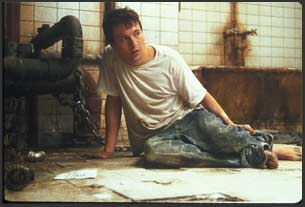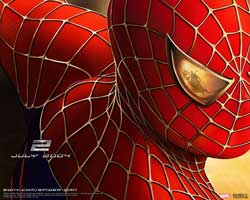Watched Downfall the other night. A German dramatisation of the last days of Hitler. Traudl Junge, a young staff typist, is our witness to the Führer’s final days and suicide. Deep under Berlin Hitler and his generals face the Russian advance and their imminent defeat.
Bruno Gantz gives a terrific performance as Adolf Hitler. The Führer is portrayed as a withered, grey old man. Bent double, shuffling with one hand shaking uncontrollably. A broken dictator.
Hitler is fanatical to the end, screaming wildly at his generals. Issuing deluded commands and conjuring up phantom regiments to defend the city. Hitler demands a decisive counterattack while condemning his commanders for their cowardice and treachery. The terrible reality is the army is broken and Germany defeated.
The bunker is cut off from the world. Insulated from the terrible battles raging above. They are a strange, isolated community existing in a concrete underground of sterile corridors and reinforced steel doors. Many of the bunker scenes are remarkable for their domesticity. Hitler takes lunch with his staff in a purpose built dining room. They eat off china plates and exchange pleasantries, commenting on the food.
The claustrophobic atmosphere of the bunker juxtaposes sharply with the terrible shelling and chaos in the city above. Children desperately man the guns as the adults turn on each other amid the chaos. Brutal execution squads roam the city hunting collaborators. They kill at will, hanging suspects in the street. The death squads insist ‘order must be restored’ and adorn their victims with makeshift signs declaring, “I sided with the red beasts”.
Denial is a constant theme. People are drunk and despairing at the hopelessness of their situation and imminent arrival of the Red army. Eva Braun is depicted as a self-obsessed hedonist, indulging in wild dancing and open drunkenness. No one can face the future. The defeat and humiliation, the moment Germans must account for Nazism.
The fanaticism of the young is shocking. A nurse collapses hysterically on seeing a broken and dishevelled Führer. Young officers declare their loyalty to Hitler and vow to fight and die rather than surrender. They blindly cling to the oath of allegiance and many commit suicide rather than fall to the Russians.
In a pathetic scene, a reproduction of Hitler’s last appearance on camera, the Führer decorates a line of bewildered child soldiers for defending Berlin.
Goebbels is depicted as a sinister figure, gaunt and limping. Fanatical to the end and devoted to Hitler and Nazism. In a terrible scene, Frau Goebbels is seen coldly administering poison to her own children. Finally having to force a reluctant Helga to drink it. Somehow it comes to symbolise the cold barbarism of the Nazis. The Goebbels then kill themselves.
As the final hours approach, Hitler is seen earnestly discussing the effectiveness of various poisons with a visiting surgeon. He instructs an aide to burn his corpse to prevent it from falling into Russian hands. Hitler and Eva Braun marry in a pathetic ceremony and retreat to their rooms to end their lives.
Leading Nazis record their final testaments and Goebbels dictates a rambling diatribe to Nazism and what could have been.
A German general tries to negotiate a desperate peace with the advancing Russians. His approach is rejected outright. Unconditional surrender is the only offer.
At the end, Hitler is dead and his generals drink and argue as the bunker staff flee.
Defeat and suicide are recurring themes. Nazism and it’s murderous ideology are defeated as Hitler and the leading Nazis commit suicide. The proud German army is beaten. As the last defenders are pushed back to within a few yards of the bunker, men kill themselves rather than surrender.
The suffering of the German people is portrayed in harrowing detail. Germany is ruined, it’s citizens left to beg in her shattered cities. The price for Nazism is paid.
As Germany’s surrender is announced, people emerge, dazed and uncertain from the ruins.
The film is about witness. Dramatising the accounts of survivors. Characters are picked out and their stories come to life through the film’s narrative. It’s important the film is made by Germans and the dialogue is in German. It lends it authenticity and makes its witness more meaningful.
The film ends with Traudl Junge’s escape from the bunker, Berlin and the war. Our witness must survive. Children are among the first to adapt to life in the ruins and a resourceful boy leads her through the Russian lines to safety.
They pull a bicycle from a river and cycle through the countryside to freedom. The boy represents a future of hope and renewal. The journey is symbolic of a new, reconstructed, democratic German nation.
As the credits roll, eerie snapshots reveal what happened to the bunker staff after the war. Many died in Russian prison camps while others survived, living to old age.
The final few minutes show Traudl Junge today, looking back and reflecting on her life and time in Hitler’s bunker. She concludes that being young was no excuse and finding things out was always possible.




